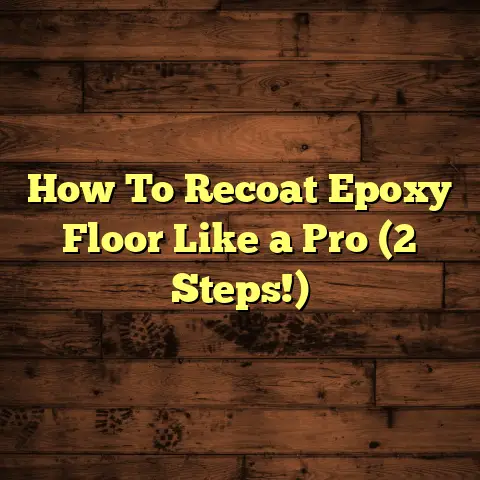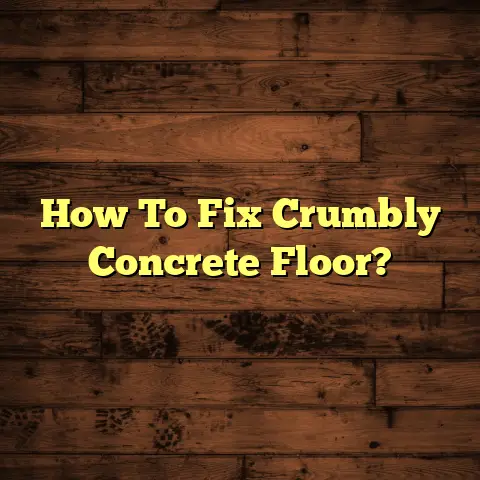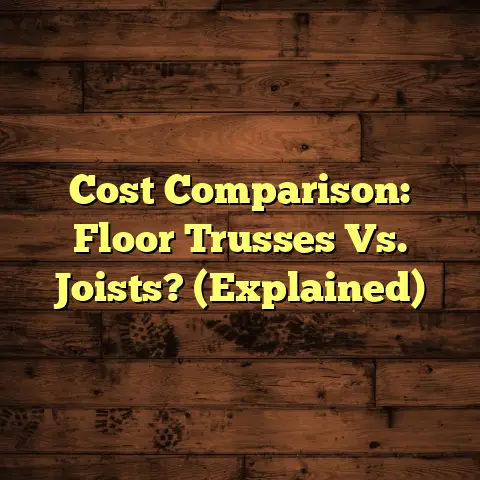How To Fix Bowing Wood Floor? (Explained)
I remember the first time I came across a bowing wood floor in a client’s home.
It was a beautiful hardwood floor, but the curves and waves made it look anything but appealing.
After years of working as a flooring contractor, I’ve seen my fair share of challenges, and bowing floors are definitely among the more frustrating ones.
I was determined to fix it, not just for the aesthetics, but because I knew how important it was for the homeowner’s comfort and investment.
Understanding the Problem
Bowing in wood floors usually occurs due to moisture issues or improper installation.
When wood absorbs moisture, it expands.
Conversely, when it dries out, it contracts.
This constant movement can lead to warping, cupping, and ultimately bowing.
In my experience, I’ve found that the most common causes include:
- High humidity: Excessive moisture in the air can cause wood to swell.
- Poor ventilation: Areas with limited airflow can trap humidity.
- Improper installation: If the flooring wasn’t installed correctly or if the subfloor isn’t level, it can lead to problems over time.
When I first encountered a bowing floor, I took a step back to assess the situation.
I wanted to understand not only how to fix it but why it happened in the first place.
This understanding has been crucial in avoiding similar issues in future projects.
A Personal Anecdote
I vividly recall a job in a charming historic home where the owners had invested significantly in restoring its original features, including the hardwood flooring.
Shortly after installation, they noticed some areas of the floor began to bow.
They were devastated—the last thing they wanted was to undo their hard work.
After inspecting the house, I discovered that the previous owner had not properly addressed moisture issues in the basement.
The lack of a dehumidifier was allowing humidity to creep up into the living area.
It was a perfect example of how underlying issues could manifest in visible problems in the flooring.
Initial Assessment
The first step I take is to identify the source of the problem.
I often ask clients about their home environment—how they maintain humidity levels, whether they’ve had any water leaks, or if they recently remodeled an area that could affect airflow.
For instance, I recall a job in a home with a finished basement.
The owners had installed a dehumidifier, but it wasn’t adequate for the size of the space.
The result?
A lovely yet bowed hardwood floor in the living area above.
Tools for Assessment
During my assessments, I utilize several tools to help diagnose issues more accurately:
- Moisture Meters: These devices can measure moisture levels in both the air and within wood itself.
They are invaluable for determining whether humidity is contributing to bowing. - Leveling Tools: A long level or straightedge helps me check for unevenness across the floor.
This ensures that I can identify low spots where water might accumulate or areas where structural issues may exist. - Infrared Thermometers: These help me detect temperature variations that might indicate moisture problems behind walls or under floors.
Having these tools on hand allows me to provide clients with a clear picture of what’s happening beneath their feet.
Fixing Bowed Floors
Once I pinpointed the cause of the bowing, it was time to explore solutions.
Here’s how I typically approach fixing bowed wood floors:
1. Moisture Control
If high humidity is the culprit, controlling moisture is essential. I recommend:
- Using dehumidifiers: These are great for reducing excess moisture in the air.
- Improving ventilation: Opening windows or installing vents can help circulate air.
- Using moisture barriers: In areas prone to dampness, such as basements, installing a moisture barrier can prevent water from seeping into the flooring.
In one instance, after addressing moisture levels in a client’s home, we saw significant improvement over just a few weeks.
Their previously bowed floor began to settle back into place.
2. Leveling the Subfloor
Sometimes the issue lies with an uneven subfloor, especially if the installation wasn’t done correctly.
Here’s what I do:
- Identify high and low spots: I use a long level or straightedge to check for dips and bumps.
- Use leveling compounds: For minor adjustments, self-leveling compounds work wonders.
- Screw down loose sections: If boards are moving due to loose subflooring, securing them can prevent further issues.
I once had a job where we discovered loose boards underneath a hardwood floor that had started to bow.
By securing everything and adding leveling compound in key spots, we were able to correct the issue effectively.
3. Reinstallation
In severe cases where bowing is extensive, reinstallation might be necessary:
- Remove affected boards: If some boards are too damaged, they need to be replaced.
- Ensure proper acclimation: Before reinstalling new boards, I always let them acclimate to the home’s environment for several days.
- Follow best practices: Installing according to manufacturer recommendations is crucial for preventing future issues.
Cost Considerations
When discussing costs with clients regarding flooring repairs, having accurate estimates is essential.
That’s where FloorTally comes into play for me.
It helps me generate precise cost estimates by pulling local material and labor rates.
For instance, when we tackled that bowed floor in the basement, I used FloorTally to provide a detailed breakdown of costs related to materials like leveling compounds and new boards.
This transparency has helped me build trust with my clients and streamline budgeting discussions.
Knowing upfront what things will cost helps everyone feel more secure and informed.
Detailed Cost Breakdown
Here’s how costs typically break down for fixing bowed wood floors:
- Moisture Control Solutions:
- Dehumidifier: $150 – $300
- Ventilation improvements: $100 – $500 (depending on scope)
- Leveling Subfloor:
- Self-leveling compound: $30 – $50 per bag (covers approximately 50 square feet)
- Labor costs for leveling: $2 – $4 per square foot
- Replacement Boards:
- Solid hardwood boards: $3 – $10 per square foot
- Engineered wood boards: $2 – $8 per square foot
In total, depending on the severity of the issue and whether reinstallation is necessary, costs can range from a few hundred dollars for minor adjustments to several thousand for extensive repairs.
Preventing Future Issues
After fixing a bowed floor, my focus shifts to preventing future problems.
Here are some strategies I share with clients:
- Regular inspections: Checking for signs of moisture or damage can prevent bigger issues down the line.
- Maintaining humidity levels: Using humidifiers in winter and dehumidifiers in summer helps keep wood stable.
- Proper cleaning habits: Avoid using excessive water when cleaning wood floors; instead, opt for dry mops and specialized cleaners.
A Case Study on Prevention
I once worked with a family who had experienced significant bowing due to fluctuating humidity levels across seasons.
After correcting their flooring issue, we implemented a regular maintenance schedule that included:
- Monthly checks on their dehumidifier settings.
- Seasonal inspections of their HVAC system to ensure proper airflow.
- Educating them on cleaning techniques that would minimize water exposure.
Over time, they reported no further issues with their floors—a clear testament to the effectiveness of proactive maintenance.
Challenges Encountered
Throughout my career, I’ve faced many challenges related to bowed flooring.
One memorable project involved an old Victorian home that had beautiful original wood floors but was suffering from serious bowing due to years of neglect.
The owners wanted to preserve as much of the original flooring as possible while addressing the issue.
It was a delicate process that required patience and creativity.
We had to remove sections of flooring carefully while maintaining others that were still intact.
In this case, we also discovered hidden water damage that required further repair not only of the flooring but also of underlying joists.
The entire process took longer than expected and required additional materials, which impacted costs.
However, seeing the homeowners’ satisfaction when we finally restored their beloved floors made every challenge worthwhile.
Success Stories
On the flip side, I’ve had several successful projects where I managed to rectify bowing issues smoothly.
One involved a modern home where I noticed minor cupping on engineered hardwood floors shortly after installation.
By adjusting the humidity levels and ensuring proper airflow through vents and windows, we managed to correct the issue without needing any major repairs or replacements.
The homeowners were thrilled with how quickly we solved their problem.
Options for Different Flooring Types
When it comes to bowing floors, different materials may require different approaches:
- Solid Hardwood: These tend to be more susceptible to moisture changes due to their thickness but can be sanded down if needed.
- Engineered Wood: Generally more stable than solid wood but can still bow if moisture levels fluctuate excessively.
- Laminate: While not as prone to bowing as wood floors, high moisture can still cause them to swell or warp.
I always remind clients that understanding their specific flooring type can influence both repair methods and preventative measures.
Technical Specifications
When dealing with different types of wood flooring, it’s essential to consider their specifications:
- Solid Hardwood: Typically ranges from 3/4 inch thick; made from single pieces of wood; more susceptible to environmental changes.
- Engineered Wood: Composed of multiple layers (usually three to five); ranges from 3/8 inch to 3/4 inch thick; more resistant to humidity fluctuations.
- Laminate Flooring: Made from composite materials with a photographic layer; generally thinner than hardwood options (around 7/16 inch) and often treated for moisture resistance.
Understanding these specifications helps me communicate effectively with clients about what they can expect regarding maintenance and potential issues.
Maintenance Tips
To keep your wood floors looking great and functioning well over time, I’ve developed some handy maintenance tips based on my experiences:
- Regular Cleaning: Use a dry mop or vacuum regularly to remove dirt and dust without harming the finish.
- Humidity Control: Invest in a hygrometer to monitor humidity levels; ideally keep them between 30% and 50%.
- Furniture Pads: Place pads under furniture legs to avoid scratches or dents that could lead to moisture accumulation.
- Area Rugs: Consider using area rugs in high-traffic zones; they not only protect but add style too!
- Prompt Repairs: Address any signs of wear or damage immediately—this includes scratches, dents, or signs of moisture damage.
Final Thoughts
Seeing a bowed wood floor can be disheartening for any homeowner.
However, with proper assessment and effective solutions, it’s often possible to restore beauty and functionality to those surfaces.
Whether it’s controlling moisture levels or ensuring proper installation techniques, each step is critical in maintaining the integrity of your flooring.
If you’re facing similar issues or just want some advice on maintaining your floors, feel free to reach out—I’m always here to help!
Comparative Analysis
When considering solutions for bowed wood floors versus other flooring options like laminate or tile, it’s essential to weigh durability against aesthetics:
- Wood Floors: While they offer timeless beauty and warmth, they require more maintenance and care regarding environmental conditions.
- Laminate Flooring: Easier to install and generally more resistant to moisture; however, it lacks the same aesthetic appeal as natural wood.
- Tile Flooring: Extremely durable and moisture-resistant; perfect for areas like kitchens and bathrooms but lacks warmth compared to wood.
In some cases, clients have chosen laminate or tile as an alternative due to concerns about future bowing issues with wood floors—especially in homes prone to high humidity levels.
By understanding these nuances between flooring types and implementing proactive measures for maintenance and care, homeowners can enjoy their spaces while minimizing future headaches.





